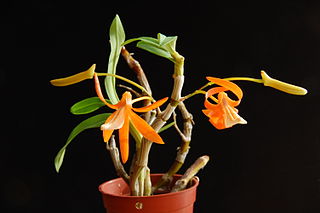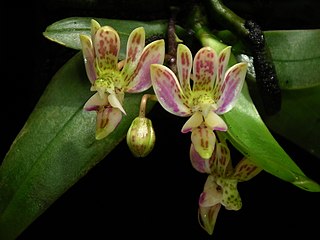
Nyssaceae is a family of flowering trees sometimes included in the dogwood family (Cornaceae). Nyssaceae is composed of 37 known species in the following five genera:
Panisea yunnanensis is a species of plant in the family Orchidaceae. It is native to China and to Vietnam.

Dendrobium falconeri, commonly known as 串珠石斛 , is a species of orchid native to Asia.

Dendrobium infundibulum, the small-funnel-lipped dendrobium, is a species of orchid. It is native to northern Indochina and to neighboring parts of China and India .

Dendrobium jenkinsii, the Jenkins's dendrobium, is a species of orchid. It is native to southern China (Yunnan), the eastern Himalayas and northern Indochina.

Dendrobium lituiflorum, the bent-racemed dendrobium, is a species of orchid. It is native to southern China, the Himalayas and northern Indochina.

Dendrobium unicum is a species of orchid, commonly known as the unique dendrobium endemic to Southeast Asia, in Thailand, Laos, and Vietnam. It was first described by Seidenfadden in 1970.
Diplopanax is a genus of flowering trees placed in the family Cornaceae or Nyssaceae. Its two known extant species inhabit the wet tropical mountains of Vietnam and southern China. They are broad-leaved evergreen trees with woody fruits and white or yellow flowers.

Pelatantheria is a genus of flowering plants from the orchid family, Orchidaceae. Its species are distributed across China, Japan, the Indian Subcontinent and Southeast Asia.
- Pelatantheria bicuspidataTang & F.T.Wang - Yunnan, Guizhou, Thailand
- Pelatantheria cristata(Ridl.) Ridl. - Thailand, Malaysia, Sumatra
- Pelatantheria ctenoglossumRidl. - Yunnan, Indochina
- Pelatantheria eakroensisHaager - Vietnam
- Pelatantheria insectifera(Rchb.f.) Ridl. - Assam, Bangladesh, India, Nepal, Bhutan, Andaman Islands, Myanmar, Thailand, Vietnam
- Pelatantheria rivesii(Guillaumin) Tang & F.T.Wang - Yunnan, Guangxi, Laos, Vietnam
- Pelatantheria scolopendrifolia(Makino) Aver. - Japan, Korea, Anhui, Fujian, Jiangsu, Shandong, Sichuan, Zhejiang
- Pelatantheria woonchengiiP.O'Byrne - Thailand
Calocedrus rupestris is a species of conifer recently discovered in highly eroded rocky limestone mountains in northern Vietnam and first described in 2004. It also occurs in China.

Pelatantheria insectifera is a species of orchid occurring in Thailand, Laos, India. The species is a long-stemmed epiphytic herb. The small flowers have a relatively large, fleshy, bright pink labellum. The specific epithet "insectifera", meaning "insect bearing", refers to the flowers, which are indicated to resemble an insect. Thus, attraction of pollinators by means of sexual deception is implied, but to date no pollinator has been published. The flowers are produced from September to October on subsessile racemes, which are shorter than the leaves. The plants are almost entirely self-incompatible, but a small percentage of self-pollination events may be successful. After pollination the colour of the labellum changes from pink to red and the sepals and petals begin to close.
Pelatantheria rivesii is a species of epiphytic or lithophytic orchid occurring in China, Laos and Vietnam. This species closely resembles Pelatantheria insectifera bothin its vegetative and generative morphology. The commonly branched stems may reach lengths of 1 m and diameters of 7 mm. Few flowers are produced during October on short racemes, which do not exceed the length of the leaves. The flowers are small and fleshy and the sepals and petals are pale yellow and bear striped. The labellum is pink.
Pelatantheria ctenoglossum is a species of epiphytic or lithophytic orchid occurring in China, Cambodia, Laos and Vietnam. This species closely resembles Pelatantheria bicuspidata both in its vegetative and generative morphology. It can also be easily confused with Pelatantheria woonchengii. The main difference lies in the morphology of the labellum. The specific epithet "ctenoglossum", meaning "comb tongue", refers to the comb like epergencies of the distal portion of the labellum. The stems are erect and rigid and bear fleshy, lanceolate and unequally bilobed leaves. The sepals are ovate, obtuse and have red striations on a yellow base colour. The labellum is fleshy and three-lobed. The column bears tufted white hairs at its base. The chromosome count is 2n = 38.
Pelatantheria bicuspidata is a species of epiphytic or lithophytic orchid occurring in China and Thailand. This species closely resembles Pelatantheria ctenoglossum and Pelatantheria woonchengii. The specific epithet bicuspidata, derived from the Latin word bicuspidatus, meaning double pointed refers to the two pointed distal portion of the labellum. The stems are elongate, branched and bear elliptic-oblong, unequally bilobed, distichously arranged leaves. The flowers open wideely and bear purple or red striations on petals and sepals. The labellum is fleshy, three-lobed and spurred at the base. The column bears tufted white hairs at its base.

Pelatantheria scolopendrifolia is a species of epiphytic or lithophytic orchid occurring in China, Japan and Korea. The plants closely adhere to the substrate and are creeping. The commonly branched, very slender stem bears distichously arranged, subcylindrical, leathery leaves. One to two widely opening flowers are produced on a short raceme, which is usually shorter than the leaves. The flowers are thinly textured and pale flesh-coloured. The labellum is spurred.
Pelatantheria woonchengii is a species of epiphytic or lithophytic orchid occurring in Vietnam, Thailand, Myanmar, and Malaysia. It may be easily misidentified as Pelatantheria ctenoglossum.
Pelatantheria cristata is a species of epiphytic or lithophytic orchid occurring in Indonesia, Thailand and Malaysia. It is similar to Pelatantheria insectifera and Pelatantheria rivesii. The stems may reach 20 cm in length and possess deflexed racemes up to 10 cm in length, bearing several flowers. The specific epithet cristata, derived from the Latin word cristatus, refers to the crested or tufted labellum.

Papilionanthe pedunculata is a species of epiphytic orchid native to Cambodia, and Vietnam. This species is a floristic component of the South Annamese endemism center, which is characterised by isolated, uplifted plateaux and high mountain systems. They are also found in dry lowland Dipterocarp forests in southern Vietnam. The plant has obvious xeromorphic features and is adapted to these dry conditions. The cool-growing plant occurs at 1200 to 1300 m. The plants are large and terete.

Vanda dives is a species of epiphytic orchid native to Vietnam and Laos.

Phalaenopsis finleyi is a species of orchid native to Myanmar, Thailand and Vietnam.










